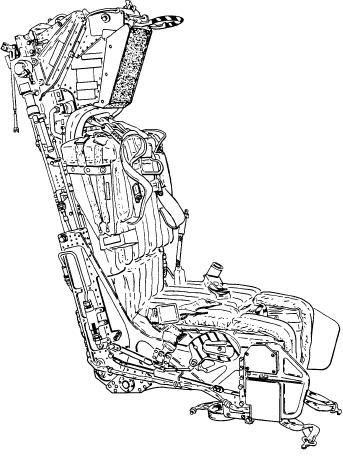
(primary firing control), the seat functions as a
The aircraft has four Martin-Baker MK-GRUEA-7
completely automatic system. Each seat is fitted with a
rocket-assisted ejection seats (fig. 1-1) installed for the
gas-operated harness retraction unit, which ensures that
pilot and three electronic countermeasures officer
the seat occupant's upper body is correctly positioned
(ECMO) crewmembers.
and retained to enable the occupant to withstand the
All seats are identical in operation and differ only
forces of ejection. The occupant's upper restraint
in time delay firing mechanism assemblies and in the
harness is pulled in and locked, and on leaving the
rocket motor inboard nozzle diameter, located on
aircraft, the occupant's legs are withdrawn, the
opposite sides, so that during ejection, each seat takes a
emergency oxygen supply is started, the timing devices
different path. Because of this, certain components of
of both the drogue gun and the time-release mechanism
the seat assemblies are designed to ensure that each seat
assemblies are started, and the rocket motor initiator
can be fitted only to its correct position. The seat gives
fires the rocket motor. When clear of the aircraft and
the occupants a maximum degree of comfort on long
approximately at the rocket motor burnout, the drogue
flights by including ventilated seat-position actuators.
gun fires to deploy the stabilizing drogue parachutes.
Each seat has height adjustment while only the pilot's
With the proper altitude and time conditions satisfied,
seat has both height and tilt (FWD/AFT) adjustment.
the time-release mechanism will activate the restraint
The primary means of ejection is through the
release system and deploy the personnel parachute,
canopy. If time permits, the canopy may be jettisoned
separating the occupant from the seat as the personnel
(only below 250 knots indicated airspeed [KIAS]) prior
parachute inflates.
to ejection. There is no interlock mechanism in this
LOWER EJECTION HANDLE
aircraft between the ejection seat and the canopy
jettison system. The canopies must be jettisoned as a
The lower ejection handle is on the forward face of
separate function.
the seat bucket in case injury or high-g conditions
Once ejection is initiated by command-sequenced
prevent the occupant from reaching overhead to use the
ejection or by individual activation of the face curtain
face curtain.
EMERGENCY RESTRAINT RELEASE
An emergency restraint release control fires the
guillotine, severing the personnel parachute withdrawal
line from the drogue parachutes and also allowing the
occupant to release all restraints as well as the
personnel survival equipment. This gives the occupant
manual escape from the seat in the event of failure of
the automatic release system or during crash and
ditching conditions.
ROCKET MOTOR
The thrust produced by the ejection gun is added to
by the rocket motor, which enables the ejection seat to
reach at least an 80-knot speed, zero-altitude.
DROGUE PARACHUTE ASSEMBLY
After ejection, the ejection seat and occupant are
stabilized and decelerated by a duplex drogue
parachute assembly, which is rapidly developed by a
cartridge-operated drogue gun. A time-release
mechanism assembly mounted on each seat
AMEf0101
automatically releases the personnel parachute
Figure 1-1.--Martin-Baker MK-GRUEA-7 rocket-assisted
container, the survival kit, the leg restraint lines, upper
ejection seat.
1-2

